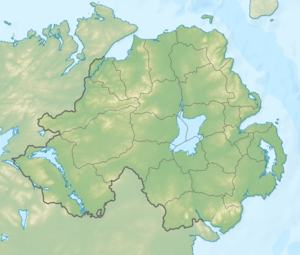Newtownhamilton bombing
| Newtownhamilton bombing | |
|---|---|
| Part of the Troubles | |
 | |
| Location | Newtownhamilton, County Armagh, Northern Ireland |
| Coordinates | 55°02′28″N 7°00′36″W / 55.041°N 7.010°WCoordinates: 55°02′28″N 7°00′36″W / 55.041°N 7.010°W |
| Date |
24 June 1998 14:20 (GMT) |
Attack type | Bombing |
| Weapons |
Time bomb Car Bomb |
| Deaths | 0 |
Non-fatal injuries | 6 |
| Perpetrator | Irish National Liberation Army (INLA) |
Suspected perpetrator | helped by Real IRA |
The Newtownhamilton bombing was a carbombing carried out by the Irish National Liberation Army (INLA) on 24 June 1998 in the Armagh border village of Newtownhamilton shortly after the signing of the 1998 Good Friday Agreement by the Irish government, British government Nationalist and Unionist parties as well as parties which represented Republican and Loyalist paramilitaries. The INLA and its political wing the IRSP were opposed to the agreement. The bombing was one of the last actions carried out or claimed by the INLA during the 30-year conflict known as the Troubles
Background
The Good Friday Agreement was signed on 10 April 1998 and was approved by most major paramilitaries on the Republican and Loyalist sides of the conflict like the Provisional IRA (PIRA) and the Ulster Volunteer Force (UVF) but was opposed by smaller dissident groups on each side like the Real IRA (RIRA, formed in 1997 after splitting with the PIRA), the Loyalist Volunteer Force (formed in 1996 after splitting with the UVF) and the INLA itself.
The car bomb attack took place during a time of high activity by dissident Irish Republicans especially by the Real IRA and Continuity IRA mainly in protest at the Good Friday Agreement which dissidents argued was a document of surrender to the British government, Sinn Féin argued it was a huge stepping stone to a United Ireland and that the armed struggle had gone as far as it could go and further loss of life was pointless and immoral.
Bombing
The car bomb exploded in the predominantly Catholic border town of Newtownhamilton close to a polling station, injuring six people including a 15-year-old boy despite the INLA giving a 50-minute warning as police were still trying to evacuate people from the bomb area. The bomb was estimated to have weighed 200 lbs and along with the injured it caused widespread damage. The financial damage from the attack was estimated at £2 million.[1] Police believed the Real IRA supplied the INLA with Semtex commercial explosive which was thought to have been used as a component in making the bomb.[2] The bombing was seen as a "protest attack" as it happened the day before Northern Ireland Assembly Elections took place on the 25 June 1998.[3]
Aftermath
Two months later on 15 August the Omagh bombing[4] caused by the Real IRA killed almost 30 people and injured over 250 more. The shock and outrage in Ireland and Britain over the human cost of the bomb was such that the Real IRA soon called a ceasefire[5] and so did the INLA on 22 August 1998[6] bringing an end to their 24-year paramilitary campaign which killed over 100 people and injured hundreds more. Almost a year later on 8 August 1999 the INLA issued a statement saying: "There is no political or moral argument to justify a resumption of the campaign."
See also
References
- ↑ "Bomb damage in village put at £2m".
- ↑ Melaugh, Dr Martin. "CAIN: Chronology of the Conflict 1998".
- ↑ Melaugh, Dr Martin. "CAIN: Issue: Politics: Elections: Assembly Election (NI) Thursday 25 June 1998".
- ↑ Sutton, Malcolm. "CAIN: Sutton Index of Deaths".
- ↑ Melaugh, Dr Martin. "CAIN: Events: Peace Process: "real" IRA statement 2, 18 August 1998".
- ↑ Melaugh, Dr Martin. "CAIN: Events: Peace: Ceasefire Statement issued by the Irish National Liberation Army (INLA), Saturday 22 August 1998".